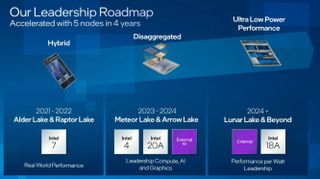Initial Intel Meteor Lake iGPU Support Queued for Linux 5.20
Newer display, media and graphics engines are present, as is resizable BAR.

Intel developers have submitted Meteor Lake graphics patches that are ready to be merged into the next version of the Linux Direct Rendering Manager (DRM-Next). Once completed, Linux 5.20 will offer initial Meteor Lake graphics support. This is yet another development that points to Meteor Lake being on track, despite some whispers from the rumor mill that it might be delayed.
Linux-centric news site Phoronix observed Intel posting Linux driver patches for Meteor Lake support earlier this month. Now, these patches are queued for addition to the i915 kernel graphics driver.
The Intel patches confirm that Meteor Lake iGPUs will offer Xe_LPD+ display engine version 14 capabilities, version 13 media block, and version 12.70 graphics block. Current Intel processors with enabled iGPUs use Xe_LPD display engine version 13, and earlier versions of both the media and graphics blocks. Sadly, we don’t know what extra features will be supported with the driver advances. However, it is expected that Meteor Lake iGPUs will be similar in capability to Intel Arc Alchemist discrete graphics, which are starting to become established in new laptops (but not desktops yet).
Elsewhere in the DRM-Next highlights are support for both Small BAR and PCIe Resizable BAR (BAR = Base Address Register) for faster memory performance. Several fixes and low-level driver changes have also been implemented – all very welcome work to smooth the arrival of a new hardware release. Lastly, concerning this Linux driver news, Phoronix notes that more Arc Alchemist and Arctic Sound M device IDs have been added to the code.

Intel Meteor Lake processors, the 14th Gen Core processor series, are noteworthy for advances on several fronts. First, these processors are expected to debut with a mix of Ocean Cove high-performance cores and efficiency cores built with EUV-enhanced Intel 4 process technology. Another major part of the “leading compute, AI, and graphics” proposition is an iGPU with between 96 and 192 EUs built on TSMC N3 technology.
The aforementioned powerful CPU and GPU cores are wrapped up with an SoC featuring a memory controller, a PCIe controller, a Thunderbolt controller, and more, leveraging Intel’s Foveros 3D packaging technology. With all this new technology combined and finessed into a finished product, there is admittedly a lot that could go wrong and cause delays. However, with the exception of a few whispers to the contrary, Intel seems to be on track for its previously stated 2023 launch goal.
Stay on the Cutting Edge
Join the experts who read Tom's Hardware for the inside track on enthusiast PC tech news — and have for over 25 years. We'll send breaking news and in-depth reviews of CPUs, GPUs, AI, maker hardware and more straight to your inbox.

Mark Tyson is a Freelance News Writer at Tom's Hardware US. He enjoys covering the full breadth of PC tech; from business and semiconductor design to products approaching the edge of reason.
Most Popular

